ARNT Antibody - #DF6154
| Product: | ARNT Antibody |
| Catalog: | DF6154 |
| Description: | Rabbit polyclonal antibody to ARNT |
| Application: | WB IHC IF/ICC |
| Reactivity: | Human, Mouse, Rat |
| Prediction: | Pig, Zebrafish, Bovine, Horse, Sheep, Rabbit, Dog, Chicken, Xenopus |
| Mol.Wt.: | 87kDa; 87kD(Calculated). |
| Uniprot: | P27540 |
| RRID: | AB_2838121 |
Related Downloads
Protocols
Product Info
*The optimal dilutions should be determined by the end user.
*Tips:
WB: For western blot detection of denatured protein samples. IHC: For immunohistochemical detection of paraffin sections (IHC-p) or frozen sections (IHC-f) of tissue samples. IF/ICC: For immunofluorescence detection of cell samples. ELISA(peptide): For ELISA detection of antigenic peptide.
Cite Format: Affinity Biosciences Cat# DF6154, RRID:AB_2838121.
Fold/Unfold
arnT; ARNT protein; ARNT_HUMAN; Aryl hydrocarbon receptor nuclear translocator; bHLHe2; Class E basic helix-loop-helix protein 2; Dioxin receptor; Dioxin receptor nuclear translocator; Drnt; HIF 1 beta; HIF 1beta; HIF-1-beta; HIF1-beta; HIF1B; HIF1beta; Hypoxia Inducible Factor 1; Hypoxia inducible factor 1 beta; Hypoxia-inducible factor 1-beta; nuclear translocator; Tango;
Immunogens
A synthesized peptide derived from human ARNT, corresponding to a region within N-terminal amino acids.
- P27540 ARNT_HUMAN:
- Protein BLAST With
- NCBI/
- ExPASy/
- Uniprot
MAATTANPEMTSDVPSLGPAIASGNSGPGIQGGGAIVQRAIKRRPGLDFDDDGEGNSKFLRCDDDQMSNDKERFARSDDEQSSADKERLARENHSEIERRRRNKMTAYITELSDMVPTCSALARKPDKLTILRMAVSHMKSLRGTGNTSTDGSYKPSFLTDQELKHLILEAADGFLFIVSCETGRVVYVSDSVTPVLNQPQSEWFGSTLYDQVHPDDVDKLREQLSTSENALTGRILDLKTGTVKKEGQQSSMRMCMGSRRSFICRMRCGSSSVDPVSVNRLSFVRNRCRNGLGSVKDGEPHFVVVHCTGYIKAWPPAGVSLPDDDPEAGQGSKFCLVAIGRLQVTSSPNCTDMSNVCQPTEFISRHNIEGIFTFVDHRCVATVGYQPQELLGKNIVEFCHPEDQQLLRDSFQQVVKLKGQVLSVMFRFRSKNQEWLWMRTSSFTFQNPYSDEIEYIICTNTNVKNSSQEPRPTLSNTIQRPQLGPTANLPLEMGSGQLAPRQQQQQTELDMVPGRDGLASYNHSQVVQPVTTTGPEHSKPLEKSDGLFAQDRDPRFSEIYHNINADQSKGISSSTVPATQQLFSQGNTFPPTPRPAENFRNSGLAPPVTIVQPSASAGQMLAQISRHSNPTQGATPTWTPTTRSGFSAQQVATQATAKTRTSQFGVGSFQTPSSFSSMSLPGAPTASPGAAAYPSLTNRGSNFAPETGQTAGQFQTRTAEGVGVWPQWQGQQPHHRSSSSEQHVQQPPAQQPGQPEVFQEMLSMLGDQSNSYNNEEFPDLTMFPPFSE
Predictions
Score>80(red) has high confidence and is suggested to be used for WB detection. *The prediction model is mainly based on the alignment of immunogen sequences, the results are for reference only, not as the basis of quality assurance.
High(score>80) Medium(80>score>50) Low(score<50) No confidence
Research Backgrounds
Required for activity of the Ah (dioxin) receptor. This protein is required for the ligand-binding subunit to translocate from the cytosol to the nucleus after ligand binding. The complex then initiates transcription of genes involved in the activation of PAH procarcinogens. The heterodimer binds to core DNA sequence 5'-TACGTG-3' within the hypoxia response element (HRE) of target gene promoters and functions as a transcriptional regulator of the adaptive response to hypoxia (By similarity). The heterodimer ARNT:AHR binds to core DNA sequence 5'-TGCGTG-3' within the dioxin response element (DRE) of target gene promoters and activates their transcription.
Nucleus.
Research Fields
· Environmental Information Processing > Signal transduction > HIF-1 signaling pathway. (View pathway)
· Human Diseases > Cancers: Overview > Pathways in cancer. (View pathway)
· Human Diseases > Cancers: Overview > Chemical carcinogenesis.
· Human Diseases > Cancers: Specific types > Renal cell carcinoma. (View pathway)
Restrictive clause
Affinity Biosciences tests all products strictly. Citations are provided as a resource for additional applications that have not been validated by Affinity Biosciences. Please choose the appropriate format for each application and consult Materials and Methods sections for additional details about the use of any product in these publications.
For Research Use Only.
Not for use in diagnostic or therapeutic procedures. Not for resale. Not for distribution without written consent. Affinity Biosciences will not be held responsible for patent infringement or other violations that may occur with the use of our products. Affinity Biosciences, Affinity Biosciences Logo and all other trademarks are the property of Affinity Biosciences LTD.




